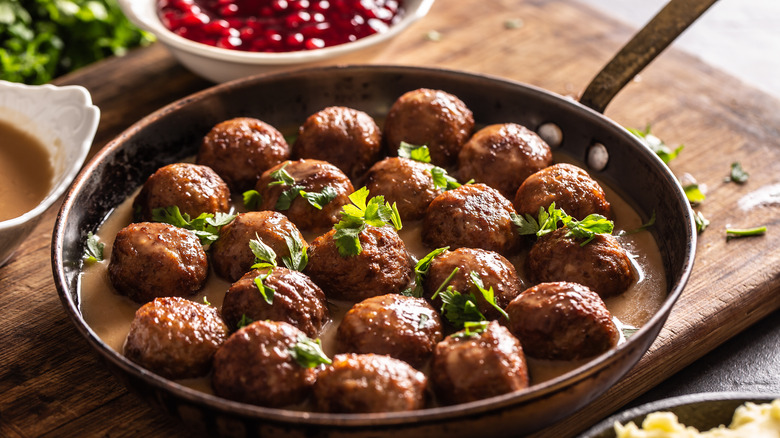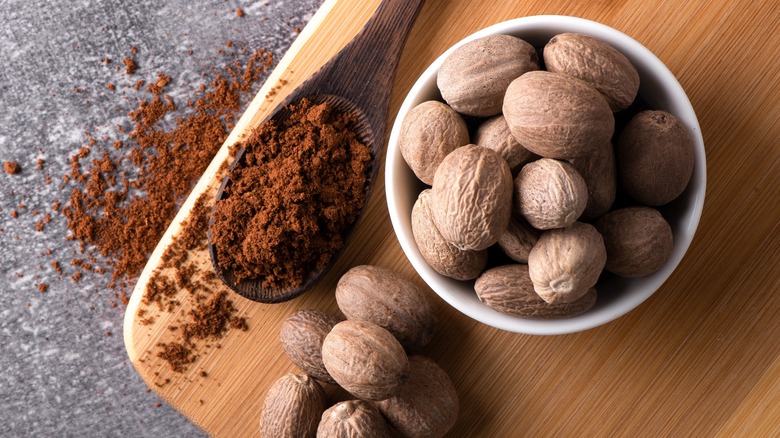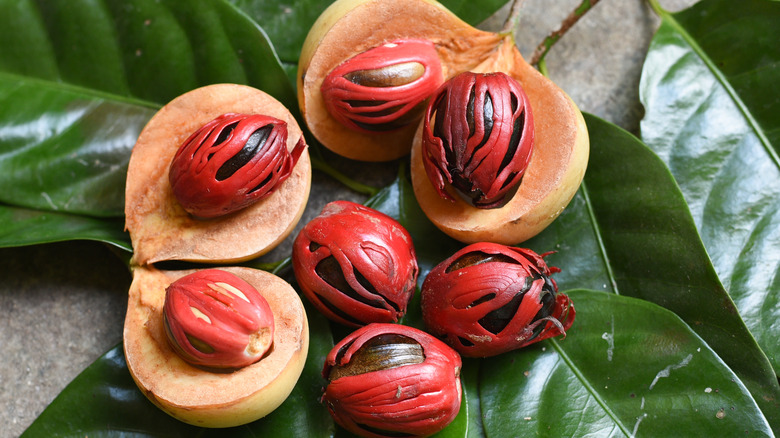The Unexpected Spice That Gives Meatballs A Bold New Flavor
There are spices that readily lend themselves to sweet dishes (hello, old-fashioned cinnamon rolls!), and spices that should be reserved for savory ones (white pepper is the secret ingredient in restaurant-worthy egg rolls). Then, there are a few spices that excel in both realms, with nutmeg being a prime example. Sure, you love it on eggnog and French toast, but did you know that a pinch of nutmeg can transform meatballs from solid to sublime?
In this case, it doesn't matter whether you're making Swedish Svenska kottbullar, Italian polpette al sugo, or meatballs from wherever your grandmother hailed: Nutmeg will mesh just as well with ground pork as it will with beef, and as effortlessly with grated parmesan as with sour cream. Its fragrant, nutty warmth enhances both the sweetness inherent in dairy and the savory qualities of steak — and a little nutmeg in your next batch of meatballs will have a significant effect while remaining undetectable. The reasons for the happy combination of nutmeg and meatballs can be (mostly) explained by science.
A moderate amount of nutmeg is all you need
According to a 2014 study in the Korean Journal for Food Science of Animal Resources, various spices influence the volatile compounds in cooked beef, and nutmeg does so in multiple ways. For starters, its antimicrobial and antibacterial properties render compounds derived from bacterial action (such as alcohols, aldehydes, hydrocarbons, and ketones) undetectable in a beef patty cooked with nutmeg. It also inhibits the production of sulfur compounds, which contribute to the odor of vegetables like cabbage and Brussels sprouts — this is why these vegetables are often cooked with nutmeg.
Nutmeg also contains a high concentration of terpenes, organic compounds known for their floral and fruity aromas, found in plants such as pine trees, rosemary, lavender, oranges, and cannabis. As reported by Medical News Today, some terpenes can have psychoactive effects similar to cannabinoids when consumed in sufficient quantities. Nutmeg includes a compound called myristicin, which, according to Healthline, can induce a "high" accompanied by very unpleasant symptoms such as gastric distress, dizziness, confusion, hallucinations, and — in at least two documented cases — seizures if consumed in excess. Therefore, it's wise to keep your nutmeg consumption moderate, whether you're adding it to meatballs or using it as a secret ingredient in unbeatable lasagna. Clearly, the properties of nutmeg as a spice are as intriguing and remarkable as the plant itself.
From incense to food additive
The small, hard, oval objects we commonly refer to as nutmeg are actually the seeds of an edible fruit produced by an Indonesian evergreen tree, enchantingly named Myristica fragrans. In Sulawesi, the nutmeg is laid out (after the nutmeg seed and its covering — another spice known as mace — have been removed), sprinkled with palm sugar, and left to ferment in the sun for several days. The nutmeg fruit resembles apricots and, after sugared fermentation, tastes somewhat like crystallized ginger.
In ancient times, the Romans burned nutmeg as incense. Once it was discovered to be a magical secret ingredient, nutmeg began appearing — and continues to appear — in cream sauces, sausages, soups, puddings, and meats. Nutmeg's flavor is pleasingly sweet yet bitter, making it as compatible with lamb as it is with cabbage. While it's delightful in butternut squash soup and sweet potato pie, wait until you try including nutmeg in your next poultry rub — or in meatballs.


